fuel type TOYOTA GR86 2022 Owners Manual (in English)
[x] Cancel search | Manufacturer: TOYOTA, Model Year: 2022, Model line: GR86, Model: TOYOTA GR86 2022Pages: 582, PDF Size: 86.38 MB
Page 14 of 582
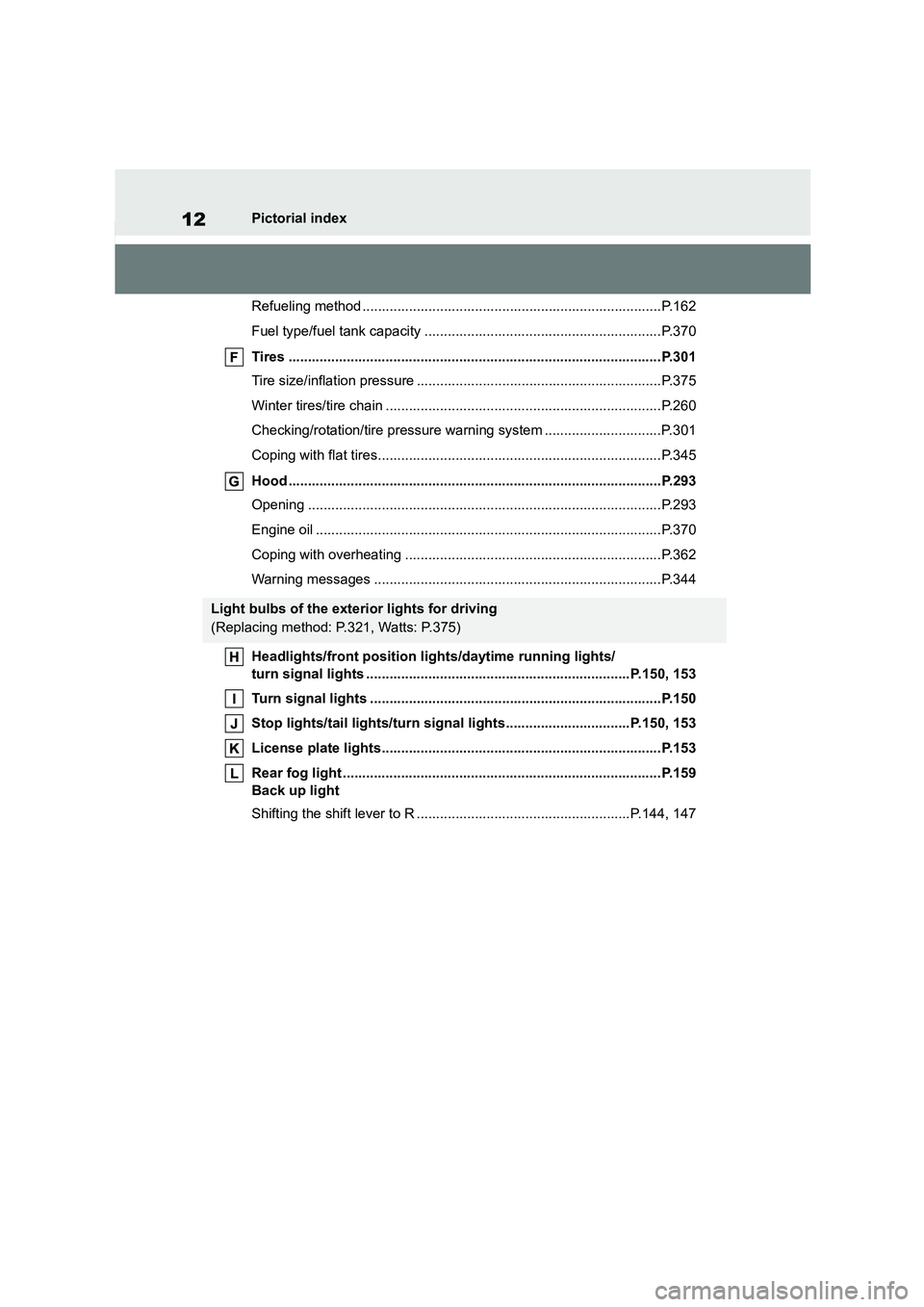
12Pictorial index
Refueling method .............................................................................P.162
Fuel type/fuel tank capacity .............................................................P.370
Tires ................................................................................................P.301
Tire size/inflation pressure ...............................................................P.375
Winter tires/tire chain .......................................................................P.260
Checking/rotation/tire pressure warn ing system ..............................P.301
Coping with flat tires.........................................................................P.345
Hood ................................................................................................P.293
Opening ...........................................................................................P.293
Engine oil .........................................................................................P.370
Coping with overheating ..................................................................P.362
Warning messages ..........................................................................P.344
Headlights/front position lights/daytime running lights/
turn signal lights ....................................................................P.150, 153
Turn signal lights ...........................................................................P.150
Stop lights/tail lights/turn signal lights................................P.150, 153
License plate lights........................................................................P.153
Rear fog light ..................................................................................P.159
Back up light
Shifting the shift lever to R .......................................................P.144, 147
Light bulbs of the exterior lights for driving
(Replacing method: P.321, Watts: P.375)
Page 134 of 582
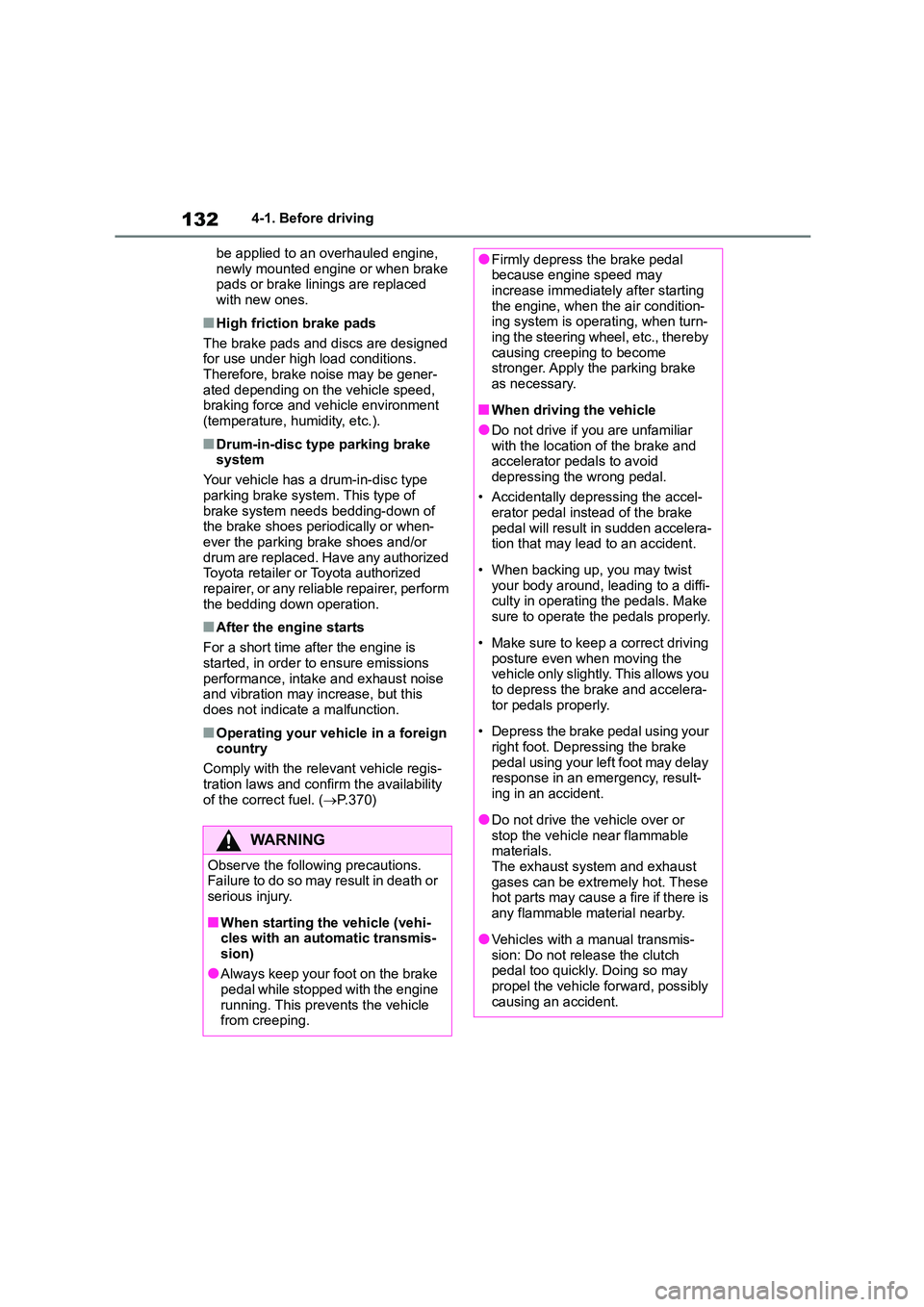
1324-1. Before driving
be applied to an overhauled engine,
newly mounted engine or when brake pads or brake linings are replaced
with new ones.
■High friction brake pads
The brake pads and discs are designed for use under high load conditions.
Therefore, brake noise may be gener-
ated depending on the vehicle speed, braking force and vehicle environment
(temperature, humidity, etc.).
■Drum-in-disc type parking brake
system
Your vehicle has a drum-in-disc type
parking brake system. This type of
brake system needs bedding-down of the brake shoes periodically or when-
ever the parking brake shoes and/or
drum are replaced. Have any authorized Toyota retailer or Toyota authorized
repairer, or any reliable repairer, perform
the bedding down operation.
■After the engine starts
For a short time after the engine is
started, in order to ensure emissions
performance, intake and exhaust noise and vibration may increase, but this
does not indicate a malfunction.
■Operating your vehicle in a foreign
country
Comply with the relevant vehicle regis-
tration laws and confirm the availability
of the correct fuel. ( P.370)
WA R N I N G
Observe the following precautions. Failure to do so may result in death or
serious injury.
■When starting the vehicle (vehi-
cles with an automatic transmis-
sion)
●Always keep your foot on the brake
pedal while stopped with the engine
running. This prevents the vehicle from creeping.
●Firmly depress the brake pedal because engine speed may
increase immediately after starting
the engine, when the air condition- ing system is operating, when turn-
ing the steering wheel, etc., thereby
causing creeping to become stronger. Apply the parking brake
as necessary.
■When driving the vehicle
●Do not drive if you are unfamiliar
with the location of the brake and accelerator pedals to avoid
depressing the wrong pedal.
• Accidentally depressing the accel- erator pedal instead of the brake
pedal will result in sudden accelera-
tion that may lead to an accident.
• When backing up, you may twist
your body around, leading to a diffi- culty in operating the pedals. Make
sure to operate the pedals properly.
• Make sure to keep a correct driving
posture even when moving the
vehicle only slightly. This allows you to depress the brake and accelera-
tor pedals properly.
• Depress the brake pedal using your
right foot. Depressing the brake
pedal using your left foot may delay response in an emergency, result-
ing in an accident.
●Do not drive the vehicle over or
stop the vehicle near flammable
materials. The exhaust system and exhaust
gases can be extremely hot. These
hot parts may cause a fire if there is any flammable material nearby.
●Vehicles with a manual transmis-
sion: Do not release the clutch pedal too quickly. Doing so may
propel the vehicle forward, possibly
causing an accident.
Page 164 of 582
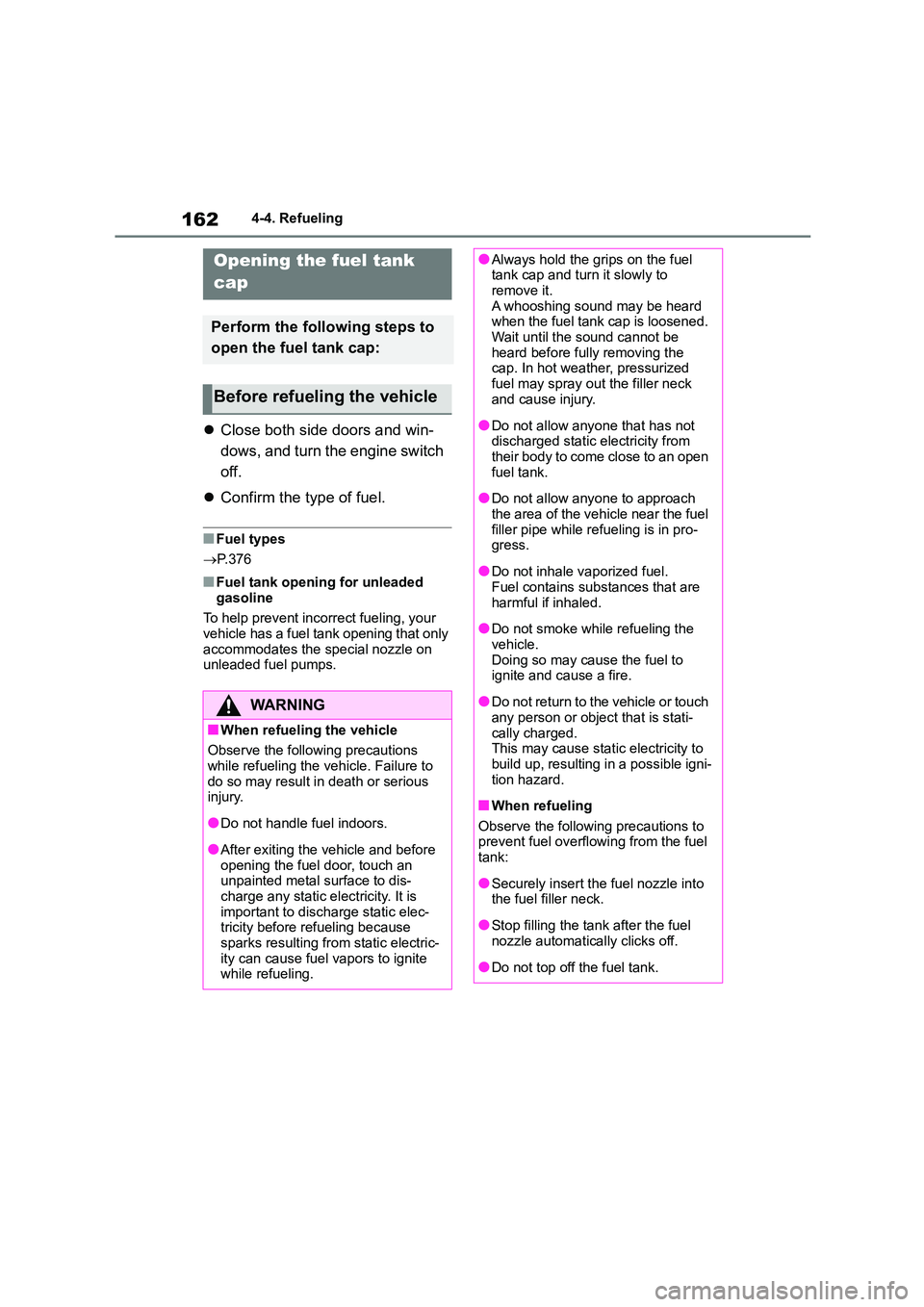
1624-4. Refueling
4-4.Refueling
Close both side doors and win-
dows, and turn the engine switch
off.
Confirm the type of fuel.
■Fuel types
P.376
■Fuel tank opening for unleaded
gasoline
To help prevent incorrect fueling, your vehicle has a fuel tank opening that only
accommodates the special nozzle on
unleaded fuel pumps.
Opening the fuel tank
cap
Perform the following steps to
open the fuel tank cap:
Before refueling the vehicle
WA R N I N G
■When refueling the vehicle
Observe the following precautions
while refueling the vehicle. Failure to
do so may result in death or serious injury.
●Do not handle fuel indoors.
●After exiting the vehicle and before
opening the fuel door, touch an unpainted metal surface to dis-
charge any static electricity. It is
important to discharge static elec- tricity before refueling because
sparks resulting from static electric-
ity can cause fuel vapors to ignite while refueling.
●Always hold the grips on the fuel tank cap and turn it slowly to
remove it.
A whooshing sound may be heard when the fuel tank cap is loosened.
Wait until the sound cannot be
heard before fully removing the cap. In hot weather, pressurized
fuel may spray out the filler neck
and cause injury.
●Do not allow anyone that has not
discharged static electricity from their body to come close to an open
fuel tank.
●Do not allow anyone to approach
the area of the vehicle near the fuel
filler pipe while refueling is in pro- gress.
●Do not inhale vaporized fuel.Fuel contains substances that are
harmful if inhaled.
●Do not smoke while refueling the
vehicle.
Doing so may cause the fuel to ignite and cause a fire.
●Do not return to the vehicle or touch any person or object that is stati-
cally charged.
This may cause static electricity to build up, resulting in a possible igni-
tion hazard.
■When refueling
Observe the following precautions to
prevent fuel overflowing from the fuel tank:
●Securely insert the fuel nozzle into the fuel filler neck.
●Stop filling the tank after the fuel
nozzle automatically clicks off.
●Do not top off the fuel tank.
Page 257 of 582
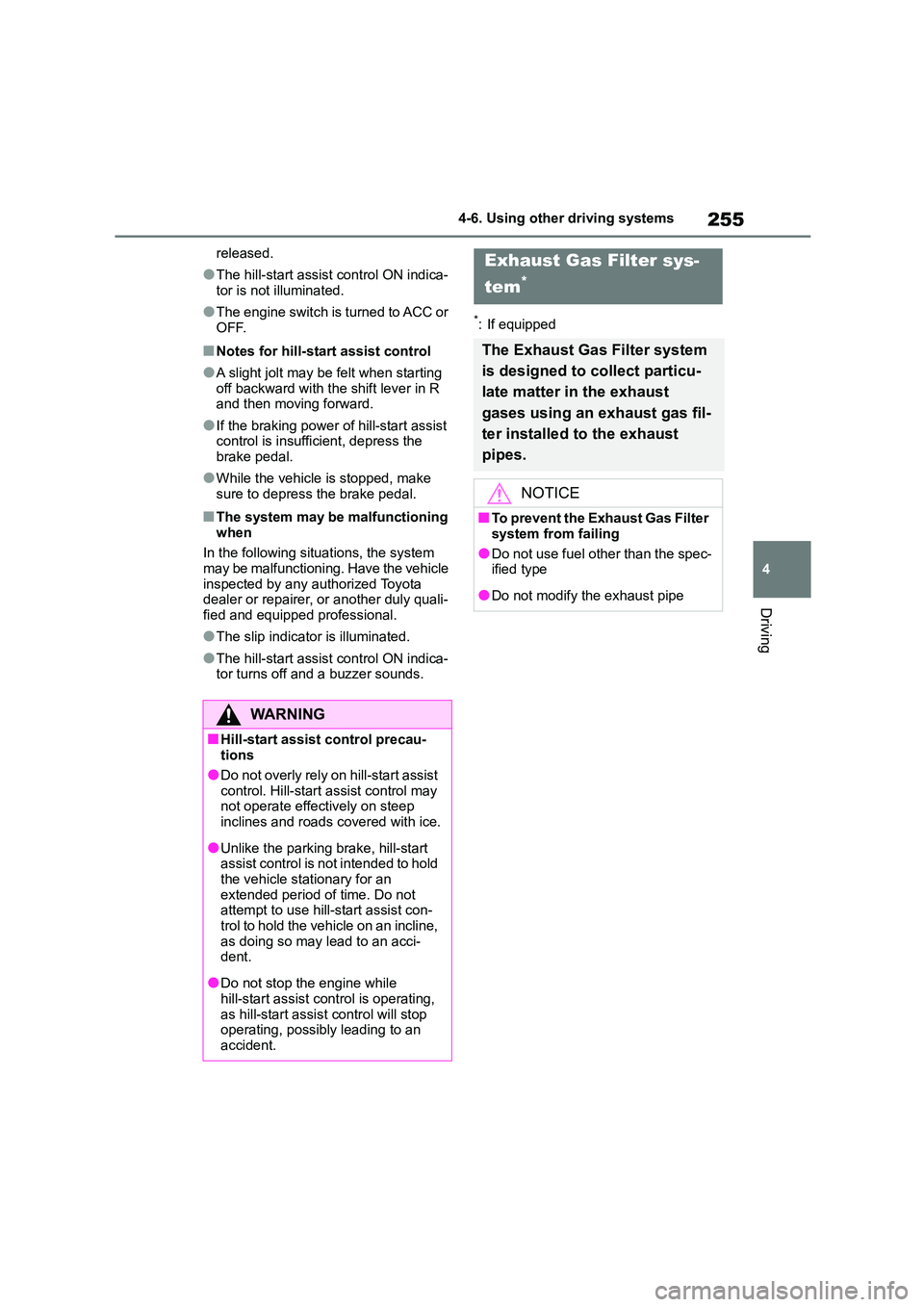
255
4
4-6. Using other driving systems
Driving
released.
●The hill-start assist control ON indica-
tor is not illuminated.
●The engine switch is turned to ACC or
OFF.
■Notes for hill-start assist control
●A slight jolt may be felt when starting
off backward with th e shift lever in R
and then moving forward.
●If the braking power of hill-start assist
control is insufficient, depress the brake pedal.
●While the vehicle is stopped, make sure to depress the brake pedal.
■The system may be malfunctioning
when
In the following situations, the system may be malfunctioning. Have the vehicle
inspected by any authorized Toyota
dealer or repairer, or another duly quali- fied and equipped professional.
●The slip indicator is illuminated.
●The hill-start assist control ON indica-
tor turns off and a buzzer sounds.
*: If equipped
WA R N I N G
■Hill-start assist control precau- tions
●Do not overly rely on hill-start assist
control. Hill-start assist control may not operate effectively on steep
inclines and roads covered with ice.
●Unlike the parking brake, hill-start
assist control is not intended to hold
the vehicle stationary for an extended period of time. Do not
attempt to use hill-start assist con-
trol to hold the vehicle on an incline, as doing so may lead to an acci-
dent.
●Do not stop the engine while
hill-start assist control is operating,
as hill-start assist control will stop operating, possibly leading to an
accident.
Exhaust Gas Filter sys-
tem*
The Exhaust Gas Filter system
is designed to collect particu-
late matter in the exhaust
gases using an exhaust gas fil-
ter installed to the exhaust
pipes.
NOTICE
■To prevent the Exhaust Gas Filter
system from failing
●Do not use fuel other than the spec- ified type
●Do not modify the exhaust pipe
Page 332 of 582
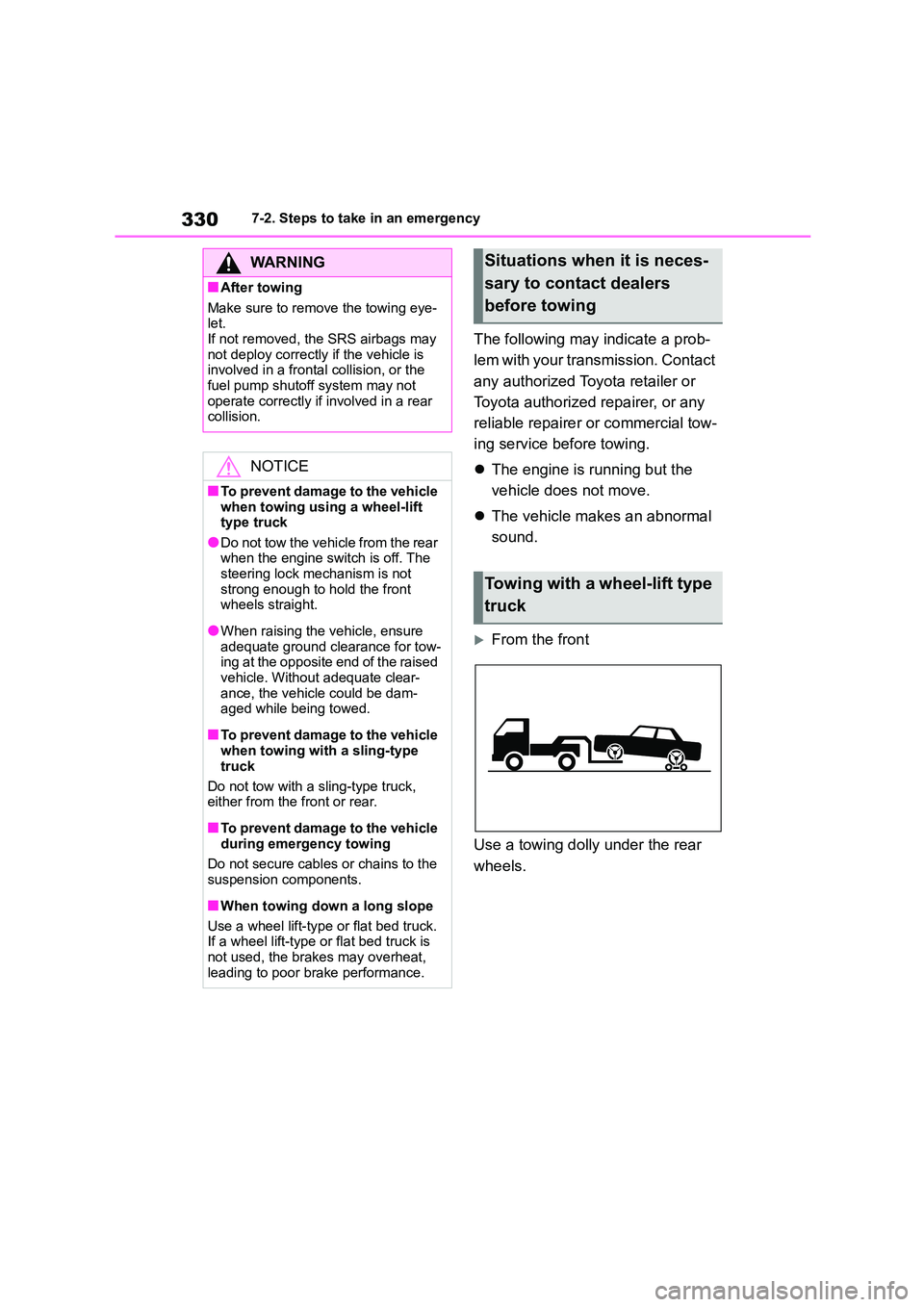
3307-2. Steps to take in an emergency
The following may indicate a prob-
lem with your transmission. Contact
any authorized Toyota retailer or
Toyota authorized repairer, or any
reliable repairer or commercial tow-
ing service before towing.
The engine is running but the
vehicle does not move.
The vehicle makes an abnormal
sound.
From the front
Use a towing dolly under the rear
wheels.
WA R N I N G
■After towing
Make sure to remove the towing eye-
let. If not removed, the SRS airbags may
not deploy correctly if the vehicle is
involved in a frontal collision, or the fuel pump shutoff system may not
operate correctly if involved in a rear
collision.
NOTICE
■To prevent damage to the vehicle when towing using a wheel-lift
type truck
●Do not tow the vehicle from the rear when the engine switch is off. The
steering lock mechanism is not
strong enough to hold the front wheels straight.
●When raising the vehicle, ensure adequate ground clearance for tow-
ing at the opposite end of the raised
vehicle. Without adequate clear-
ance, the vehicle could be dam- aged while being towed.
■To prevent damage to the vehicle when towing with a sling-type
truck
Do not tow with a sling-type truck, either from the front or rear.
■To prevent damage to the vehicle during emergency towing
Do not secure cables or chains to the
suspension components.
■When towing down a long slope
Use a wheel lift-type or flat bed truck. If a wheel lift-type or flat bed truck is
not used, the brakes may overheat,
leading to poor brake performance.
Situations when it is neces-
sary to contact dealers
before towing
Towing with a wheel-lift type
truck
Page 372 of 582

3708-1. Specifications
*: If unleaded gasoline with a Research Octane Number of 98 is not available,
unleaded gasoline with a Research Octane Number of 95 may be used with no
detriment to engine durability or driveability.
■Oil capacity (Drain and refill [Reference*])
*: The engine oil capacity is a reference quantity to be used when changing the
engine oil. Warm up and turn off the engine, wait more than 5 minutes, and check
the oil level on the dipstick.
■Engine oil selection
“Toyota Genuine Motor Oil” is used
in your Toyota vehicle. Use Toyota
approved “Toyota Genuine Motor
Oil” or equivalent to satisfy the fol-
lowing grade and viscosity.
Oil grade:
0W-20, 5W-20 and 5W-30:
API grade SL “Energy-Conserving”,
SM “Energy-Conserving”, SN
“Resource-Conserving” or SN
PLUS “Resource-Conserving”; or
ILSAC GF-5 multigrade engine oil
Recommended viscosity (SAE):
SAE 0W-20 is filled in to your Toyota
vehicle at manufacturing, and the
best choice for good fuel economy
and good starting in cold weather.
If SAE 0W-20 is not available, SAE
5W-20 oil may be used. However, it
must be replaced with SAE 0W-20
Fuel
Fuel type
When you find these types of fuel label at
the gas station, use only the fuel with one
of the following labels.
EU area: Unleaded gasoline conforming
to European standard EN228 only
Except EU area: Unleaded gasoline only
Research Octane Number98 or higher*
Fuel tank capacity (Reference)50 L (13.2 gal., 11.0 Imp. gal.)
Lubrication system
With filter5.0 L (5.3 qt., 4.4 Imp. qt.)
Without filter4.8 L (5.1 qt., 4.2 Imp. qt.)
Page 375 of 582

373
8
8-1. Specifications
Vehicle specifications
*: Your Toyota vehicle is filled with “Toyota Genuine Differential Gear Oil LX” at the
factory. Use Toyota approved “Toyota G enuine Differential Gear Oil LX” or an
equivalent of matching quality to satisfy the above specification. Please contact
any authorized Toyota dealer or repairer, or another duly qualified and equipped
professional for further details.
*: The fluid capacity is provided as a reference.
If replacement is necessary, contact any au thorized Toyota dealer or repairer, or
another duly qualified and equipped professional.
Differential
Oil capacity (Reference)1.15 L (1.22 qt., 1.01 Imp. qt.)
Oil type and viscosity* Toyota Genuine Differential Gear Oil LX
Other LSD gear oil that meets API GL-5 and
SAE 75W-85
NOTICE
■Differential gear oil type
Using a differential gear oil other than “Toyota Genuine Differential Gear Oil LX” may cause occurrences of noises, vibrations and poor fuel consumption. Never
use different brands together.
Automatic transmission
Fluid capacity*7.5 L (7.9 qt., 6.6 Imp. qt.)
Fluid typeToyota Genuine ATF WS
NOTICE
■Transmission fluid type
Using automatic transmission fluid other than “TOYOTA Genuine ATF WS” may
cause deterioration in shift quality, locking up of your transmission accompanied by vibration, and ultimately damage the automatic transmission of your vehicle.
Manual transmission
Fluid capacity*2.2 L (2.3 qt., 1.9 Imp. qt.)
Fluid type
Use either of the following:
“MT GEAR OIL LV 75W”
Other gear oil that meets API GL-4* and SAE
75W specifications
Page 376 of 582
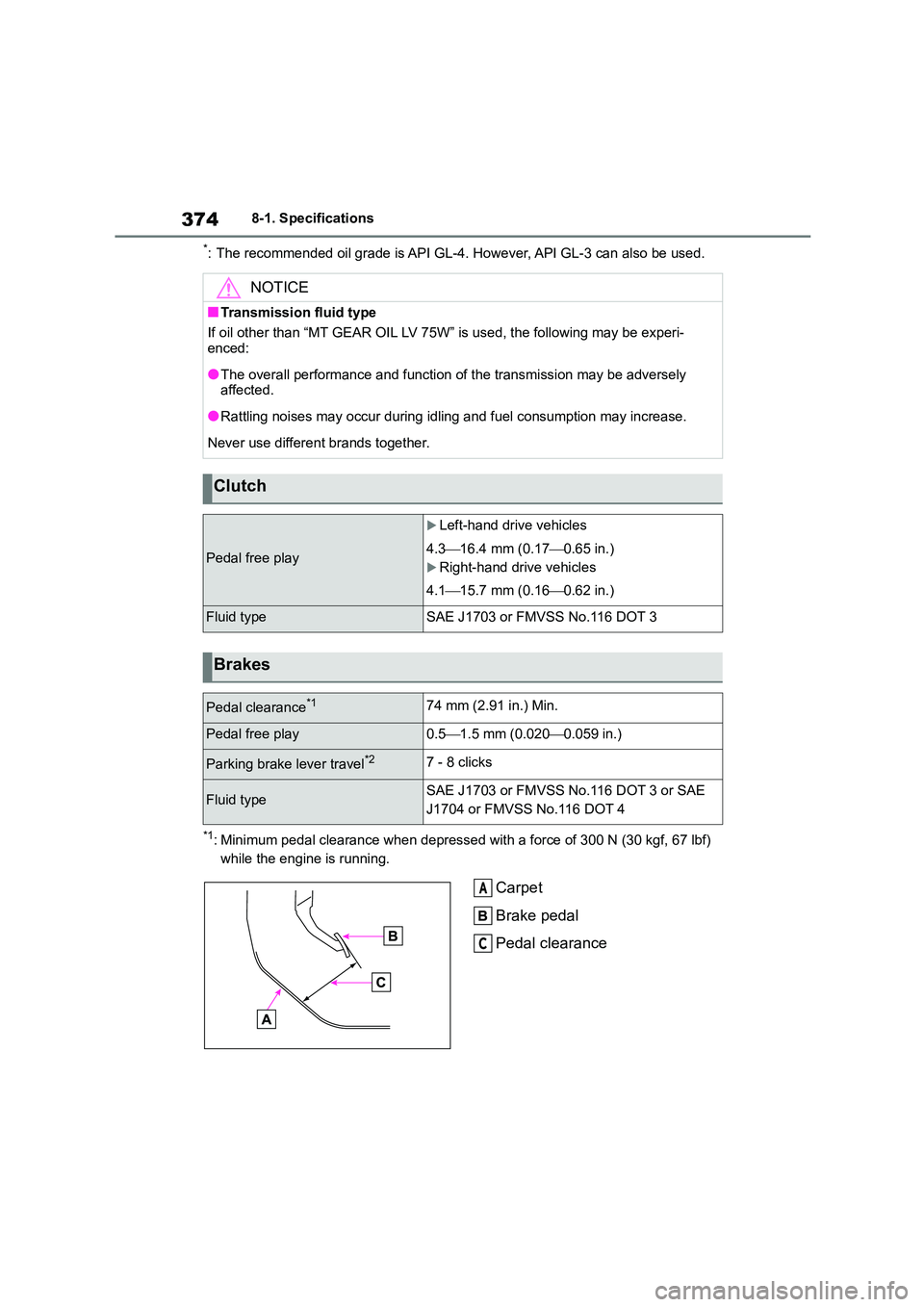
3748-1. Specifications
*: The recommended oil grade is API GL-4. However, API GL-3 can also be used.
*1: Minimum pedal clearance when depressed with a force of 300 N (30 kgf, 67 lbf)
while the engine is running.
Carpet
Brake pedal
Pedal clearance
NOTICE
■Transmission fluid type
If oil other than “MT GEAR OIL LV 75W” is used, the following may be experi- enced:
●The overall performance and function of the transmission may be adversely affected.
●Rattling noises may occur during idling and fuel consumption may increase.
Never use different brands together.
Clutch
Pedal free play
Left-hand drive vehicles
4.3 16.4 mm (0.170.65 in.)
Right-hand drive vehicles
4.1 15.7 mm (0.160.62 in.)
Fluid typeSAE J1703 or FMVSS No.116 DOT 3
Brakes
Pedal clearance*174 mm (2.91 in.) Min.
Pedal free play0.51.5 mm (0.0200.059 in.)
Parking brake lever travel*27 - 8 clicks
Fluid typeSAE J1703 or FMVSS No.116 DOT 3 or SAE
J1704 or FMVSS No.116 DOT 4
A
C
Page 378 of 582
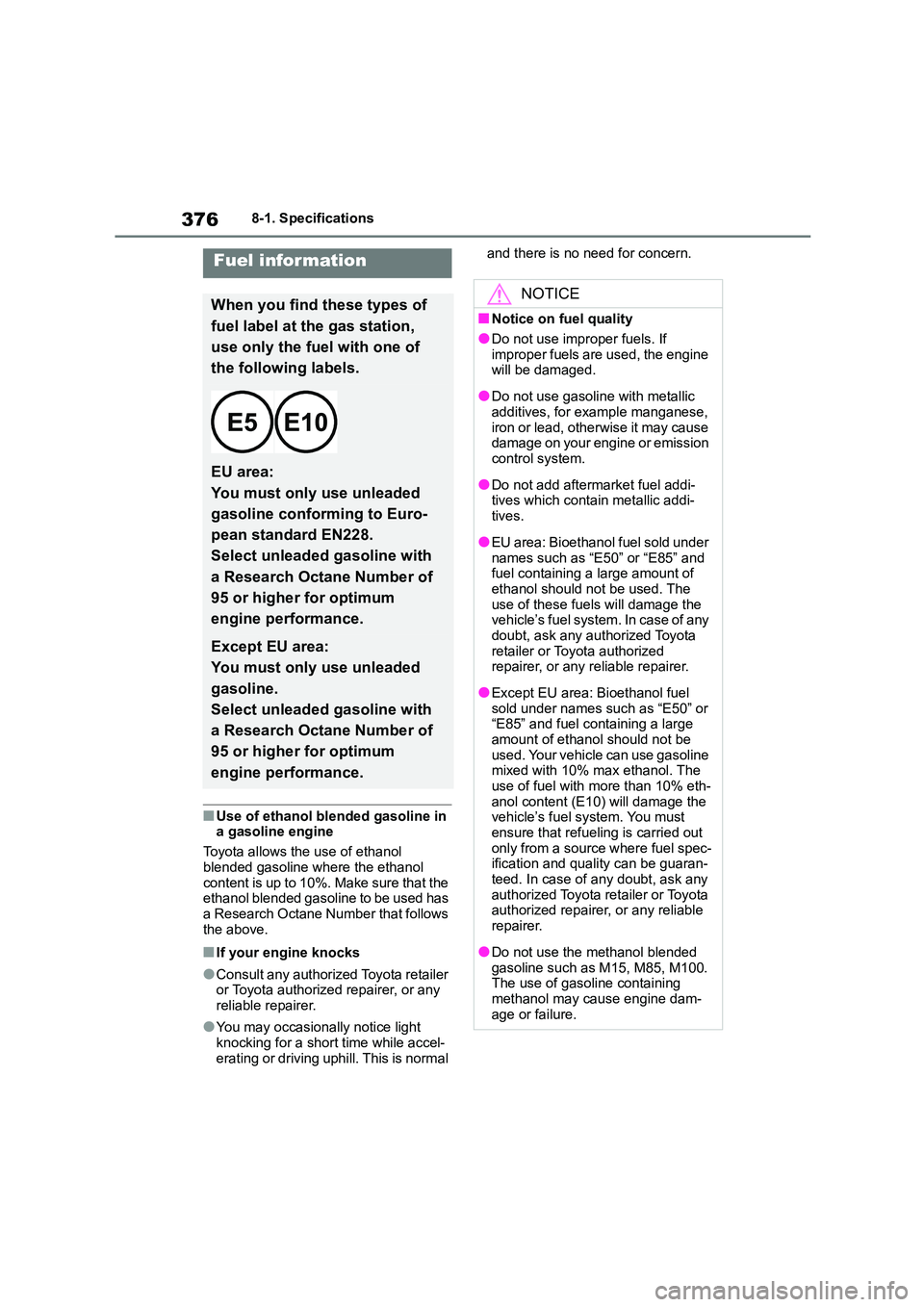
3768-1. Specifications
■Use of ethanol blended gasoline in
a gasoline engine
Toyota allows the use of ethanol
blended gasoline where the ethanol
content is up to 10%. Make sure that the ethanol blended gasoline to be used has
a Research Octane Number that follows
the above.
■If your engine knocks
●Consult any authorized Toyota retailer
or Toyota authorized repairer, or any reliable repairer.
●You may occasionally notice light knocking for a short time while accel-
erating or driving uphill. This is normal
and there is no need for concern.Fuel infor mation
When you find these types of
fuel label at the gas station,
use only the fuel with one of
the following labels.
EU area:
You must only use unleaded
gasoline conforming to Euro-
pean standard EN228.
Select unleaded gasoline with
a Research Octane Number of
95 or higher for optimum
engine performance.
Except EU area:
You must only use unleaded
gasoline.
Select unleaded gasoline with
a Research Octane Number of
95 or higher for optimum
engine performance.
NOTICE
■Notice on fuel quality
●Do not use improper fuels. If
improper fuels are used, the engine
will be damaged.
●Do not use gasoline with metallic
additives, for example manganese,
iron or lead, otherwise it may cause damage on your engine or emission
control system.
●Do not add aftermarket fuel addi-
tives which contain metallic addi-
tives.
●EU area: Bioethanol fuel sold under
names such as “E50” or “E85” and fuel containing a large amount of
ethanol should not be used. The
use of these fuels will damage the vehicle’s fuel system. In case of any
doubt, ask any authorized Toyota
retailer or Toyota authorized repairer, or any reliable repairer.
●Except EU area: Bioethanol fuel sold under names such as “E50” or
“E85” and fuel containing a large
amount of ethanol should not be used. Your vehicle can use gasoline
mixed with 10% max ethanol. The
use of fuel with more than 10% eth- anol content (E10) will damage the
vehicle’s fuel system. You must
ensure that refue ling is carried out only from a source where fuel spec-
ification and quality can be guaran-
teed. In case of any doubt, ask any authorized Toyota retailer or Toyota
authorized repairer, or any reliable
repairer.
●Do not use the methanol blended
gasoline such as M15, M85, M100. The use of gasoline containing
methanol may cause engine dam-
age or failure.
Page 394 of 582
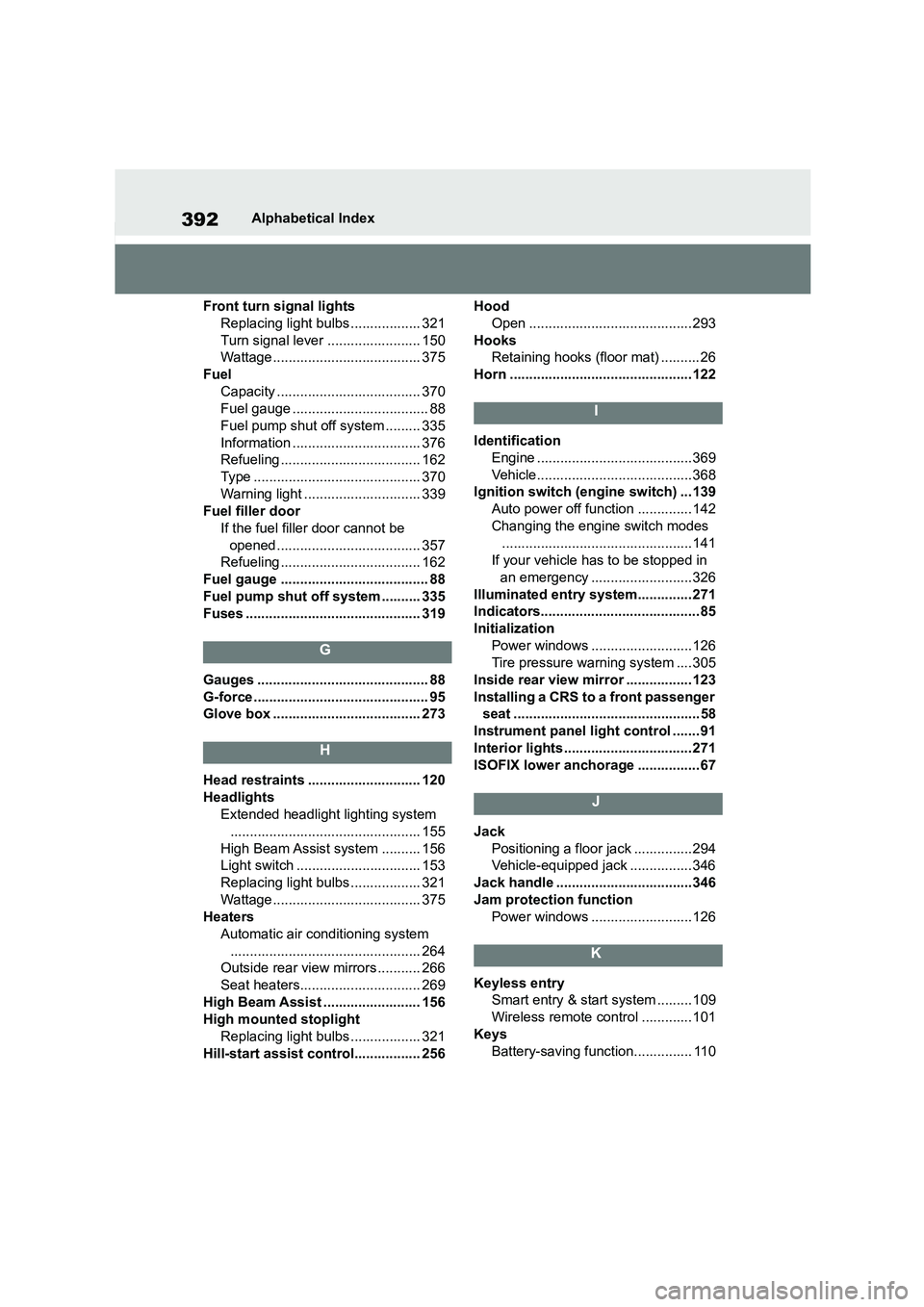
392Alphabetical Index
Front turn signal lights
Replacing light bulbs .................. 321
Turn signal lever ........................ 150
Wattage...................................... 375
Fuel
Capacity ..................................... 370
Fuel gauge ................................... 88
Fuel pump shut of f system ......... 335
Information ................................. 376
Refueling .................................... 162
Type ........................................... 370
Warning light .............................. 339
Fuel filler door
If the fuel filler door cannot be
opened..................................... 357
Refueling .................................... 162
Fuel gauge ...................................... 88
Fuel pump shut off system .......... 335
Fuses ............................................. 319
G
Gauges ............................................ 88
G-force............................................. 95
Glove box ...................................... 273
H
Head restraints ............................. 120
Headlights
Extended headlight lighting system
................................................. 155
High Beam Assist system .......... 156
Light switch ................................ 153
Replacing light bulbs .................. 321
Wattage...................................... 375
Heaters
Automatic air conditioning system
................................................. 264
Outside rear view mirrors ........... 266
Seat heaters............................... 269
High Beam Assist ......................... 156
High mounted stoplight
Replacing light bulbs .................. 321
Hill-start assist control................. 256
Hood
Open .......................................... 293
Hooks
Retaining hooks (floor mat) .......... 26
Horn ............................................... 122
I
Identification
Engine ........................................369
Vehicle........................................368
Ignition switch (engine switch) ... 139
Auto power off function .............. 142
Changing the engine switch modes
.................................................141
If your vehicle has to be stopped in
an emergency ..........................326
Illuminated entry system.............. 271
Indicators......................................... 85
Initialization
Power windows .......................... 126
Tire pressure warning system .... 305
Inside rear view mirror ................. 123
Installing a CRS to a front passenger
seat ................................................ 58
Instrument panel light control ....... 91
Interior lights ................................. 271
ISOFIX lower anchorage ................ 67
J
Jack
Positioning a floor jack ...............294
Vehicle-equipped jack ................346
Jack handle ...................................346
Jam protection function
Power windows .......................... 126
K
Keyless entry
Smart entry & start system .........109
Wireless remote control .............101
Keys
Battery-saving function............... 110